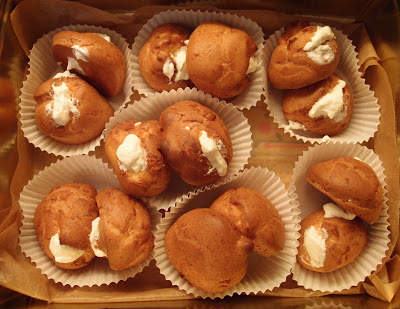This recipe comes from the January 2013 edition of Olive
magazine. As soon as I saw it I promoted
it to the top of the baking order – it uses Lindt balls, pistachios and fondant
icing...what’s not to love? In my old
age, I find all-over fondant icing can be a bit sickly so I liked the idea of
drizzling it rather than submerging the cakes in it a la Mr Kipling.
The sponge is a wonderful green thanks to the pistachios; if
there’s a better coloured nut I’ve not seen it!
They also keep the sponge moist so these cakes will keep for several
days (that’s the theory, anyway - I won't get to find out with this batch!)
I’d not used fondant icing sugar before and made the glaze
how I would a normal icing sugar glaze.
I soon realised this was a mistake – the fondant icing stays runny for
much longer and is thinner than it looks in the mixing bowl. Make it much thicker than you normally would
and then marvel at how it oozes down the cakes – it’s like magic!
The white chocolate Lindt ball topping is genius and works really well. Any white chocolate truffle would suffice but the little demi-sphere looks so cute. Both Mr CC and I are a sucker for Lindor so any excuse to buy a box is most welcome!
Well, this is the final post of the year – I’ll be honest,
it’s a year I’ll be glad to see the back of so here’s hoping 2013 is a good
one! Happy New Year to all my lovely
readers!
Ingredients
For the
sponge:
100g pistachio kernels
150g golden caster sugar
150g unsalted butter, at room temperature
3 eggs
150g self raising flour
2 tablespoons milk, you may possibly need more
8 white chocolate Lindt Lindor balls, cut in half
150g golden caster sugar
150g unsalted butter, at room temperature
3 eggs
150g self raising flour
2 tablespoons milk, you may possibly need more
8 white chocolate Lindt Lindor balls, cut in half
For the
icing:
300g fondant icing sugar
water – the amount will vary but start with 2 teaspoons
water – the amount will vary but start with 2 teaspoons
Method
Preheat the oven to 190°/fan oven 170°C/375°F/gas mark 5.
Line a 20cm square cake tin with baking paper.
Put the pistachios in a food processor and blitz until you
have even, small pieces.
Add the sugar and blitz again.
Add the butter and pulse until you have a thick paste.
Add the eggs and flour and blitz until you have a smooth
batter.
If the batter is not at dropping consistency, add the milk
and pulse. Test again and add more milk
until you have the right consistency.
Spoon into the prepared cake tin and level the surface.
Bake for approximately 20 minutes or until a skewer inserted
into the cake comes out clean. Mine took
about 22 minutes.
Leave to cool – in the tin – on a wire rack for 15 minutes
then lift out of the tin and leave to cool completely on the wire rack.
When cool trim the edges from the cake – this ensures that
each cake cube will look the same.
Cut the cake into 16 squares and place them, a little
distance apart, on the wire rack. Make
sure there is a large square of foil or baking paper under the wire rack – it should
be slightly bigger than the rack in order to catch all spills!
Cut each Lindt ball in half (they have a central join seam
and if you use that you will get clean halves).
Place each half on top of a cube of cake.
Now make the icing: place the fondant icing sugar in a bowl
and beat in 2 teaspoons of water. Fondant
icing sugar is different to ordinary icing sugar and I found it paid to make
the glaze much thicker than I normally would –it stayed runny for longer so you
need it thicker to hold on to the cake!
Spoon the icing over the cakes ensuring that the Lindt balls
are covered. It will run down the sides,
which is why it’s important to make it a thick glaze – you don’t want it all to
end up on the foil.
Place each cube of cake into a paper case – at this point I
put them in the fridge for 20 minutes to firm up the glace. They don’t need to be kept in the fridge
beyond that.
Bask in the glory of the wonderful thing you have created.
Eat.











































